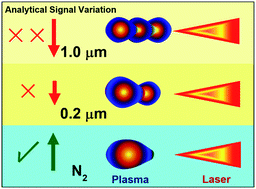Plasma imaging for physical variations in laser-induced aerosol plasma with particle size increase†
Abstract
Analytical signal repeatability of the techniques based on laser induced photoionization of aerosols is largely affected by the physical variations in laser–aerosol interaction process. Laser-induced breakdown spectroscopy is especially influenced by these variations since emission from laser–aerosol interaction is taken as a source of analytical signal. In this paper, quantified plasma imaging is presented for physical changes in laser induced plasma of aerosols with particle size. Event-to-event individuality increased with particle size as shown by decreased statistical correlation of plasma images. At optimum delay, average correlation coefficient decreased from 0.931 to 0.856 for particle size increase from 0.2 μm to 1.0 μm. Comparison with pure N2 plasma results showed that repeatability seriously deteriorates for a multi-phase aerosol ablation compared to uni-phase gaseous photoionization. Physical measurements of plasma dimensions showed a shift of ablation region towards laser beam with particle size increase. Average plasma length increased from 4.25 mm to 4.82 mm for the same size increase. These results reveal that increased individuality, plasma length and shift in ablation region are the contributing factors behind the higher uncertainty of aerosol plasma emission with particle size.



 Please wait while we load your content...
Please wait while we load your content...